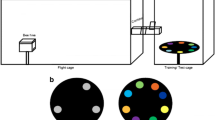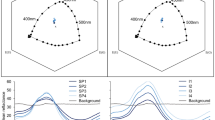Abstract
Flower-naive honeybees Apis mellifera L. flying in an enclosure were tested for their colour preferences. Bees were rewarded once on an achromatic (grey, aluminium or hardboard), or on a chromatic (ultraviolet) disk. Since naive bees never alighted on colour stimuli alone, a scent was given in combination with colour. Their landings on twelve colour stimuli were recorded. Results after one reward (“first test”) were analysed separately from those obtained after few rewards (“late tests”).
-
1)
After pre-training to achromatic signals, bees preferred, in the first test, bee-uv-blue and bee-green colours. With increasing experience, the original preference pattern persisted but the choice of bee-blue and bee-green colours increased.
-
2)
Neither colour distance of the test stimuli to the background or to the pre-training signal, nor their intensity, nor their green contrast, accounted for the colour choice of bees. Choices reflected innate preferences and were only associated with stimulus hue.
-
3)
Bees learned very quickly the pre-trained chromatic stimulus, the original colour preferences being thus erased.
-
4)
Colour preferences were strongly correlated with flower colour and its associated nectar reward, as measured in 154 flower species.
-
5)
Colour preferences also resemble the wavelength dependence of colour learning demonstrated in experienced bees.
Similar content being viewed by others
References
Backhaus W (1991) Color opponent coding in the visual system of the honeybee. Vision Res 31: 1381–1397
Backhaus W (1992) Color vision in honey bees. Neurosci Biobehav Rev 16: 1–12
Backhaus W (1993) Color vision and color choice behavior of the honeybee. Apidologie 24: 309–331
Backhaus W, Menzel R (1987) Color distance derived from a receptor model of color vision in the honeybee. Biol Cybern 55: 321–331
Backhaus W, Menzel R, Kreißl S (1987) Multidimensional scaling of color similarity in bees. Biol Cybern 56: 293–304
Banschbach VS (1994) Colour association influences honey bee choice between sucrose concentrations. J Comp Physiol A 175: 107–114
Brandt R, Backhaus W, Dittrich M, Menzel R (1993) Simulation of threshold spectral sensitivity according to the color theory for the honeybee. In: Heisenberg M, Elsner N (eds) Gene-Brain-Behaviour. Proc 21st Göttingen Neurobiology Conference. Thieme, Stuttgart, pp 374
Butler CG (1951) The importance of perfume on the discovery of food by the worker honeybee Apis mellifera L. Proc R Soc Lond B 138: 403–413
Chittka L (1992) The colour hexagon: a chromaticity diagram based on photoreceptor excitations as a generalized representation of colour opponency. J Comp Physiol A 170: 533–543
Chittka L, Lunau K (1992) Color coding and innate preferences for flower color patterns in bumblebees. In: Elsner N, Richter DW (eds) Rhythmogenesis in neurons and networks. Proc 20th Göttingen Neurobiology Conference 1993. Thieme, Stuttgart, p 298
Chittka L, Menzel R (1992) The evolutionary adaptation of flower colours and the insect pollinators' colour vision. J Comp Physiol A 171: 171–181
Chittka L, Beier W, Hertel H, Steinmann E, Menzel R (1992) Opponent coding is a universal strategy to evaluate the photoreceptor inputs in Hymenoptera. J Comp Physiol A 170: 545–563
Chittka L, Gumbert A, Kunze J, Shmida A, Menzel R (1993) What is the informational content of a flower colour? In: Proc Sprengel Symposium, Berlin-Spandau
Chittka L, Shmida A, Troje N, Menzel R (1994) Ultraviolet as a component of flower reflections, and the colour perception of Hymenoptera. Vision Res 34: 1489–1508
Darwin Ch (1877) The effects of cross- and self-fertilization in the vegetable kingdom. Murray, London
Daumer K (1956) Reizmetrische Untersuchung des Farbensehens der Bienen. Z Vergl Physiol 38: 413–478
Düll R, Kutzelnigg H (1994) Botanisch-Ökologisches Exkursion-staschenbuch. Quelle & Meyer, Heidelberg Wiesbaden
Frisch K von (1967) The dance language and orientation of bees. Belknap Press, Cambridge
Giurfa M (1991) Colour generalization and choice behaviour of the honeybee Apis mellifera ligustica. J Insect Physiol 37: 41–44
Gould JL (1984) Natural history of honey bee learning. In: Marler P, Terrace HS (eds) The biology of learning. Springer, Berlin, pp 149–180
Greggers U, Menzel R (1993) Memory dynamics and foraging strategies of honeybees. Behav Ecol Sociobiol 32: 17–29
Heinrich B, Mudge PR, Deringis PG (1977) Laboratory analysis of flower constancy in foraging bumblebees: Bombus ternarius and B. terricola. Behav Ecol Sociobiol 2: 247–265
Helversen O von (1972) Zur spektralen Unterschiedsempfindlichkeit der Honigbiene. J Comp Physiol 80: 439–472
Kien J, Menzel R (1977) Chromatic properties of interneurons in the optic lobes of the bees. I. Broad band neurons. J Comp Physiol 113: 17–34
Lehrer M (1987) To be or not to be a colour-seeing bee. Israel J Entomol 21: 51–76
Lehrer M (1993) Parallel processing of motion, shape and colour in the visual system of the bee. In: Wiese K, Gribakin FG, Popov AV, Reinninger G (eds) Sensory systems of arthropods. Birkhäuser, Basel, pp 266–272
Lieke E, Menzel R (1983) Antagonistic color effects in spatial vision of honeybees. J Comp Physiol 151: 441–448
Lunau K (1990) Colour saturation triggers innate reactions to flower signals: flower dummy experiments with bumblebees. J Comp Physiol A 166: 827–834
Lunau K (1991) Innate flower recognition in bumblebees (Bombus terrestris, B. lucorum; Apidae): optical signals from stamens as landing reaction releasers. Ethology 88: 203–214
Lunau K (1992) Innate recognition of flowers by bumble bees: orientation of antennae to visual stamen signals. Can J Zool 70: 2139–2144
Menzel R (1967) Untersuchungen zum Erlernen von Spektralfarben durch die Honigbiene (Apis mellifica). Z Vergl Physiol 56: 22–62
Menzel R (1968) Das Gedächtnis der Honigbiene für Spektralfarben. I. Kurzzeitiges und langzeitiges Behalten. Z Vergl Physiol 60: 82–102
Menzel R (1985) Learning in honeybees in an ecological and behavioral context. In: Hölldobler B, Lindauer M (eds) Experimental behavioral ecology. Fischer, Stuttgart, pp 55–74
Menzel R, Backhaus W (1991) Colour vision in insects. In: Gouras P (ed) Vision and visual dysfunction. The perception of colour. MacMillan, London, pp 262–288
Menzel R, Greggers U (1985) Natural phototaxis and its relationship to colour vision in honeybees. J Comp Physiol A 157: 311–321
Menzel R, Shmida A (1993) The ecology of flower colours and the natural colour vision of insect pollinators: the Israeli flora as a study case. Biol Rev 68: 81–120
Menzel R, Freudel H, Rühl U (1973) Rassenspezifische Unterschiede im Lernverhalten der Honigbiene (Apis mellifica L.). Apidologie 4: 1–24
Oettingen-Spielberg T (1949) Über das Wesen der Suchbiene. Z Vergl Physiol 31: 459–489
Pritsch G (1985) Bienenweide. VEB Deutscher Landwirtschaftsverlag, Berlin
Real L (1981) Uncertainty and pollinator-plant interactions: the foraging behavior of bees and wasps on artificial flowers. Ecology 62: 20–26
Srinivasan MV, Lehrer M (1984) Temporal acuity of honeybee vision: behavioural studies using moving stimuli. J Comp Physiol A 155: 297–312
Wyszecki G, Stiles WS (1982) Color science: concepts and methods. Quantitative data and formulae. Second Ed. Wiley, New York
Zar JH (1985) Biostatistical analysis. Prentice Hall, New Jersey
Author information
Authors and Affiliations
Rights and permissions
About this article
Cite this article
Giurfa, M., Núñez, J., Chittka, L. et al. Colour preferences of flower-naive honeybees. J Comp Physiol A 177, 247–259 (1995). https://doi.org/10.1007/BF00192415
Accepted:
Issue Date:
DOI: https://doi.org/10.1007/BF00192415




